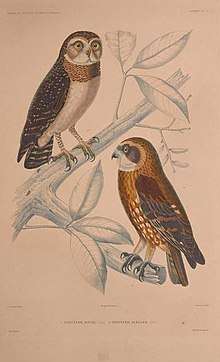Solomons boobook
| Solomons boobook | |
|---|---|
 | |
| Ninox jacquinoti (figure 1) illustrated by Paul Louis Oudart | |
| Scientific classification | |
| Kingdom: | Animalia |
| Phylum: | Chordata |
| Class: | Aves |
| Order: | Strigiformes |
| Family: | Strigidae |
| Genus: | Ninox |
| Species: | N. jacquinoti |
| Binomial name | |
| Ninox jacquinoti (Bonaparte, 1850) | |
The Solomons boobook (Ninox jacquinoti), also known as the Solomons hawk-owl, is a small to medium-sized hawk owl, measuring 23–31 cm (9.1–12.2 in) in length. Its upperparts are rusty brown, sometimes spotted or barred with white, its chest is buffy white, sometimes spotted or barred with brown, and its creamy belly is unmarked. It has a grayish-brown facial disc, edged by narrow white eyebrows and a band of white across the throat.[2]
When he first described the species in 1850, Charles Lucien Bonaparte assigned it to the genus Athene.[3] The specific epithet honors Charles Hector Jacquinot, a French explorer who spent considerable time in the Pacific.[4] Its common name refers the Solomon Islands, on which it occurs.[5]
Native to both the Solomon Islands and Papua New Guinea, it is found in tropical or subtropical moist forests in lowlands and foothills, up to 1,500 m (4,900 ft) above sea level.[6] It is nocturnal, hunting primarily insects and small vertebrates. By day, it roosts either in a cavity or in the main fork of a tree.[2]
Although its global population has not been quantified, it is reported to be widespread and common within its restricted range. The population trend appears to be stable, though small numbers of both adults and juveniles are known to be taken from the wild to serve as pets.[6]
References
- ↑ BirdLife International (2012). "Ninox jacquinoti". IUCN Red List of Threatened Species. Version 2013.2. International Union for Conservation of Nature. Retrieved 26 November 2013.
- 1 2 Duncan, James R. (2003). Owls of the World: Their Lives, Behavior and Survival. Buffalo, NY: Firefly Books. p. 284. ISBN 978-1-55297-845-0.
- ↑ König, Claus; Weick, Friedhelm (2008). Owls of the World. London, UK: Christopher Helm. pp. 466–467. ISBN 978-0-7136-6548-2.
- ↑ Jobling, James A. (2010). The Helm Dictionary of Scientific Bird Names. London, UK: Christopher Helm. p. 210. ISBN 978-1-4081-2501-4.
- ↑ Stickney, Eleanor H (2009). The "Whys" of Bird Names. New York, NY: Vantage Press. p. 158. ISBN 978-0-533-16080-8.
- 1 2 "Species: Solomons Boobook". Birdlife International. Retrieved 4 February 2012.
